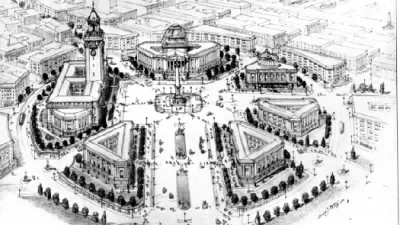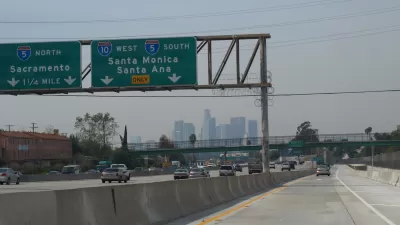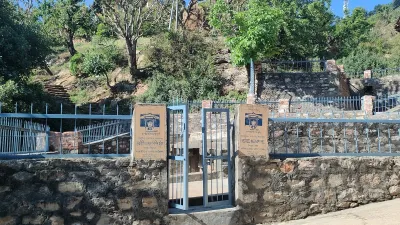Over the next few months, Congress will continue to debate health insurance reform, and in particular, whether to create a "public option"- a government-financed insurance company which would compete with private health insurers. Opponents of the public option fear that the government package might drive private insurers out of business. Are such concerns legitimate? American transportation history may give ammunition to both supporters and opponents of the public option.
Over the next few months, Congress will continue to debate health insurance reform, and in particular, whether to create a "public option"- a government-financed insurance company which would compete with private health insurers. Opponents of the public option fear that the government package might drive private insurers out of business. Are such concerns legitimate? American transportation history may give ammunition to both supporters and opponents of the public option.
A century ago, American urban transportation was far more privatized than it is today. The dominant form of transportation (other than the private horse and foot) was the privately financed streetcar. Streets were often privately financed, and in 1880 most American streets were not paved.
But in the early 20th century, government at all levels decided to facilitate bicycle and automotive transportation through a "public option" of massive street construction. In the first decades of the 20th century, municipal governments paved existing streets; by 1924, nearly all urban streets were paved. In succeeding decades, government at all levels widened those streets to accommodate automobile traffic, and eventually built limited-access expressways to accommodate even more automobile traffic.
By facilitating auto travel to places where public transit was inconvenient, the "public option" of wide public roads reduced transit ridership, eventually making private transit unprofitable. In short, 20th-century American street and road construction was a slow-motion nationalization of transportation: government created a public facility that simply outcompeted its private rival.
Eventually, unprofitable transit companies were themselves taken over by government, creating the modern public transit agencies we know today. But this second "public option", despite its recent growth, has certainly been less successful than the auto-oriented public option of the 20th century.
This is so for a variety of reasons. To name a few:
*the second public option has been less generously funded than the first - not just because government spends more every year on highways than on transit, but also because even if government spent more on transit, it would take decades to make up for the "head start" that the highway industry obtained in the early 20th century (when government spent money on auto-oriented streets but nothing on public transit) and the late 20th century (when government spent more money on highways than on public transit).
*government backed up its first "public option" with government regulation: zoning and planning rules that, by reducing population density and separating housing from other uses, created neighborhoods that would be very expensive to serve with public transit.
*the first "public option" was not exclusively public: while we drive on publicly funded streets, we do so with cars and fuel bought from private industries- industries that can lobby government for money for roads and for government bailouts when times get tough, back up its lobbying with campaign contributions, and glamorize its product with advertising designed to make auto travel seem seductive. By contrast, public transit agencies cannot make campaign contributions- and because the first "public option" made public transit unprofitable, transit agencies have limited resources for advertising and lobbying.
So what does this tell us about health care? That it is simply too early to tell how a public option will affect the private insurance industry. A well-funded public option backed up with supportive government regulation and by support from private industry might well make private insurance less profitable. On the other hand, a poorly funded public option, like today's poorly funded public transit, is no threat to private health insurance.

Planetizen Federal Action Tracker
A weekly monitor of how Trump’s orders and actions are impacting planners and planning in America.

Maui's Vacation Rental Debate Turns Ugly
Verbal attacks, misinformation campaigns and fistfights plague a high-stakes debate to convert thousands of vacation rentals into long-term housing.

San Francisco Suspends Traffic Calming Amidst Record Deaths
Citing “a challenging fiscal landscape,” the city will cease the program on the heels of 42 traffic deaths, including 24 pedestrians.

Defunct Pittsburgh Power Plant to Become Residential Tower
A decommissioned steam heat plant will be redeveloped into almost 100 affordable housing units.

Trump Prompts Restructuring of Transportation Research Board in “Unprecedented Overreach”
The TRB has eliminated more than half of its committees including those focused on climate, equity, and cities.

Amtrak Rolls Out New Orleans to Alabama “Mardi Gras” Train
The new service will operate morning and evening departures between Mobile and New Orleans.
Urban Design for Planners 1: Software Tools
This six-course series explores essential urban design concepts using open source software and equips planners with the tools they need to participate fully in the urban design process.
Planning for Universal Design
Learn the tools for implementing Universal Design in planning regulations.
Heyer Gruel & Associates PA
JM Goldson LLC
Custer County Colorado
City of Camden Redevelopment Agency
City of Astoria
Transportation Research & Education Center (TREC) at Portland State University
Jefferson Parish Government
Camden Redevelopment Agency
City of Claremont






























